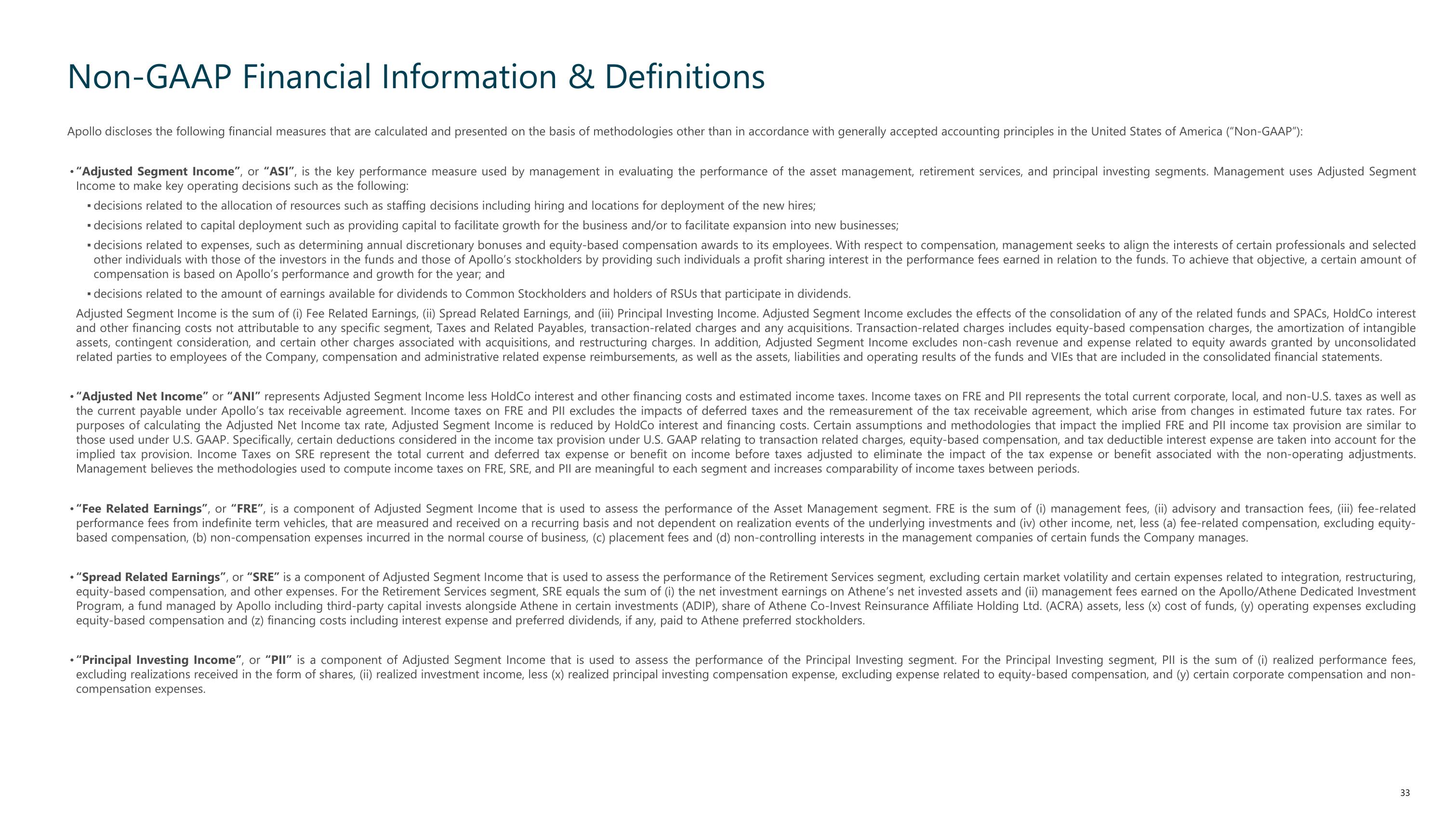Apollo Global Management Investor Presentation Deck
Non-GAAP Financial Information & Definitions
Apollo discloses the following financial measures that are calculated and presented on the basis of methodologies other than in accordance with generally accepted accounting principles in the United States of America ("Non-GAAP"):
• "Adjusted Segment Income", or "ASI", is the key performance measure used by management in evaluating the performance of the asset management, retirement services, and principal investing segments. Management uses Adjusted Segment
Income to make key operating decisions such as the following:
▪ decisions related to the allocation of resources such as staffing decisions including hiring and locations for deployment of the new hires;
▪ decisions related to capital deployment such as providing capital to facilitate growth for the business and/or to facilitate expansion into new businesses;
▪ decisions related to expenses, such as determining annual discretionary bonuses and equity-based compensation awards to its employees. With respect to compensation, management seeks to align the interests of certain professionals and selected
other individuals with those of the investors in the funds and those of Apollo's stockholders by providing such individuals a profit sharing interest in the performance fees earned in relation to the funds. To achieve that objective, a certain amount of
compensation is based on Apollo's performance and growth for the year; and
▪decisions related to the amount of earnings available for dividends to Common Stockholders and holders of RSUS that participate in dividends.
Adjusted Segment Income is the sum of (i) Fee Related Earnings, (ii) Spread Related Earnings, and (iii) Principal Investing Income. Adjusted Segment Income excludes the effects of the consolidation of any of the related funds and SPACs, HoldCo interest
and other financing costs not attributable to any specific segment, Taxes and Related Payables, transaction-related charges and any acquisitions. Transaction-related charges includes equity-based compensation charges, the amortization of intangible
assets, contingent consideration, and certain other charges associated with acquisitions, and restructuring charges. In addition, Adjusted Segment Income excludes non-cash revenue and expense related to equity awards granted by unconsolidated
related parties to employees of the Company, compensation and administrative related expense reimbursements, as well as the assets, liabilities and operating results of the funds and VIEs that are included in the consolidated financial statements.
• "Adjusted Net Income" or "ANI" represents Adjusted Segment Income less HoldCo interest and other financing costs and estimated income taxes. Income taxes on FRE and Pll represents the total current corporate, local, and non-U.S. taxes as well as
the current payable under Apollo's tax receivable agreement. Income taxes on FRE and PII excludes the impacts of deferred taxes and the remeasurement of the tax receivable agreement, which arise from changes in estimated future tax rates. For
purposes of calculating the Adjusted Net Income tax rate, Adjusted Segment Income is reduced by HoldCo interest and financing costs. Certain assumptions and methodologies that impact the implied FRE and Pll income tax provision are similar to
those used under U.S. GAAP. Specifically, certain deductions considered in the income tax provision under U.S. GAAP relating to transaction related charges, equity-based compensation, and tax deductible interest expense are taken into account for the
implied tax provision. Income Taxes on SRE represent the total current and deferred tax expense or benefit on income before taxes adjusted to eliminate the impact of the tax expense or benefit associated with the non-operating adjustments.
Management believes the methodologies used to compute income taxes on FRE, SRE, and PII are meaningful to each segment and increases comparability of income taxes between periods.
• "Fee Related Earnings", or "FRE", is a component of Adjusted Segment Income that is used to assess the performance of the Asset Management segment. FRE is the sum of (i) management fees, (ii) advisory and transaction fees, (iii) fee-related
performance fees from indefinite term vehicles, that are measured and received on a recurring basis and not dependent on realization events of the underlying investments and (iv) other income, net, less (a) fee-related compensation, excluding equity-
based compensation, (b) non-compensation expenses incurred in the normal course of business, (c) placement fees and (d) non-controlling interests in the management companies of certain funds the Company manages.
• "Spread Related Earnings", or "SRE" is a component of Adjusted Segment Income that is used to assess the performance of the Retirement Services segment, excluding certain market volatility and certain expenses related to integration, restructuring,
equity-based compensation, and other expenses. For the Retirement Services segment, SRE equals the sum of (i) the net investment earnings on Athene's net invested assets and (ii) management fees earned on the Apollo/Athene Dedicated Investment
Program, a fund managed by Apollo including third-party capital invests alongside Athene in certain investments (ADIP), share of Athene Co-Invest Reinsurance Affiliate Holding Ltd. (ACRA) assets, less (x) cost of funds, (y) operating expenses excluding
equity-based compensation and (z) financing costs including interest expense and preferred dividends, if any, paid to Ath ne preferred stockholders.
. "Principal Investing Income", or "PII" is a component of Adjusted Segment Income that is used to assess the performance of the Principal Investing segment. For the Principal Investing segment, PII is the sum of (i) realized performance fees,
excluding realizations received in the form of shares, (ii) realized investment income, less (x) realized principal investing compensation expense, excluding expense related to equity-based compensation, and (y) certain corporate compensation and non-
compensation expenses.
33View entire presentation